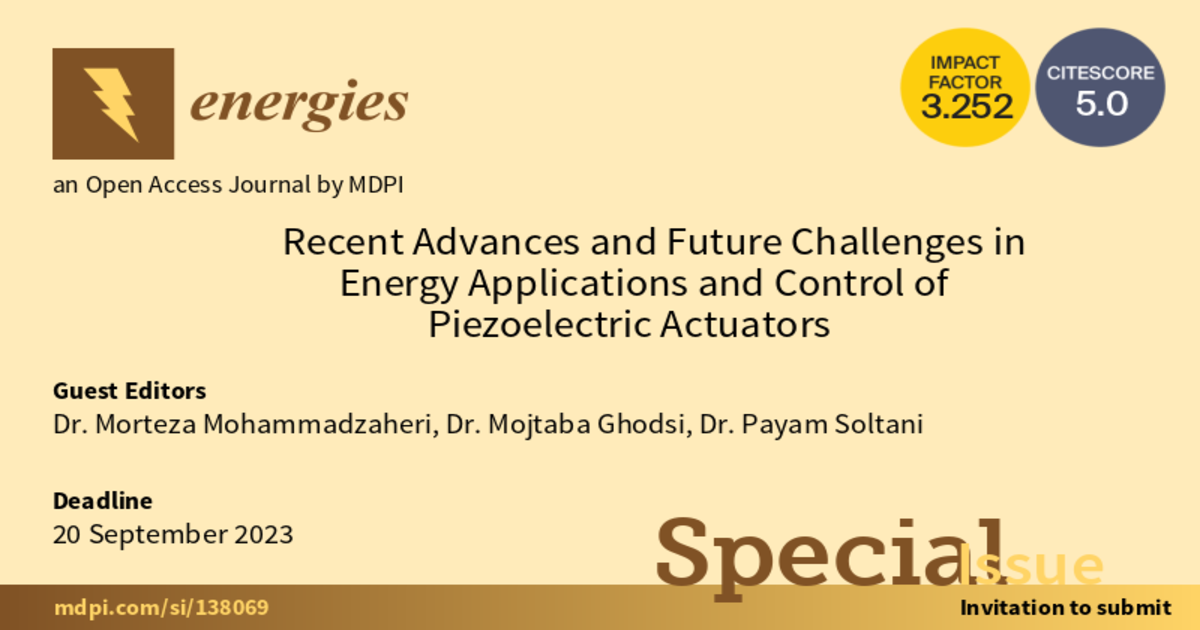Recent Advances and Future Challenges in Energy Applications and Control of Piezoelectric Actuators
A special issue of Energies (ISSN 1996-1073). This special issue belongs to the section "F: Electrical Engineering".
Deadline for manuscript submissions: closed (20 September 2023) | Viewed by 4210

Special Issue Editors
Interests: artificial intelligence for engineering; control; piezoelectric actuators
Special Issues, Collections and Topics in MDPI journals
Interests: kinetic energy harvesters; linear generators and motors; smart materials and structures
Special Issues, Collections and Topics in MDPI journals
Interests: smart materials and structures; simulation; nonlinear dynamics; energy harvesting; vibration absorbers
Special Issues, Collections and Topics in MDPI journals
Special Issue Information
Dear Colleagues,
Piezoelectric actuators, well-known for their compact size and high stiffness, convert electrical energy to mechanical energy. As a result, they generate both force and displacement. The control of a piezoelectric actuator may be categorised as displacement or force control based on the extent of the (blocking) force exerted on the actuator. In micro/nanopositioning, e.g., in scanning probe microscopy, cell manipulation and fine guidance systems, the force is tiny and neglected, and displacement/position control is the prominent task. On the other hand, in vibration control or force generation, force control is the major concern.
This Special Issue covers the current challenges in the control of piezoelectric actuators as well as their applications as piezoelectric motors, energy harvesters, etc.
Topics of interest for publication include, but are not limited to:
- Displacement/position control of piezoelectric actuators;
- Force control of piezoelectric actuators;
- Vibration control with piezoelectric actuators;
- Energy harvesting with piezoelectric materials;
- Dual use of piezoelectric materials for actuation and sensing;
- Displacement/position estimation of piezoelectric actuators with use of other signals;
- Force estimation of piezoelectric actuators with use of other signals;
- Charge control of piezoelectric actuators;
- Piezoelectric motors;
- Charge estimation of piezoelectric actuators;
- Modelling of piezoelectric actuators and their behaviour (hysteresis, creep, etc.).
Dr. Morteza Mohammadzaheri
Dr. Mojtaba Ghodsi
Dr. Payam Soltani
Guest Editors
Manuscript Submission Information
Manuscripts should be submitted online at www.mdpi.com by registering and logging in to this website. Once you are registered, click here to go to the submission form. Manuscripts can be submitted until the deadline. All submissions that pass pre-check are peer-reviewed. Accepted papers will be published continuously in the journal (as soon as accepted) and will be listed together on the special issue website. Research articles, review articles as well as short communications are invited. For planned papers, a title and short abstract (about 100 words) can be sent to the Editorial Office for announcement on this website.
Submitted manuscripts should not have been published previously, nor be under consideration for publication elsewhere (except conference proceedings papers). All manuscripts are thoroughly refereed through a single-blind peer-review process. A guide for authors and other relevant information for submission of manuscripts is available on the Instructions for Authors page. Energies is an international peer-reviewed open access semimonthly journal published by MDPI.
Please visit the Instructions for Authors page before submitting a manuscript. The Article Processing Charge (APC) for publication in this open access journal is 2600 CHF (Swiss Francs). Submitted papers should be well formatted and use good English. Authors may use MDPI's English editing service prior to publication or during author revisions.
Benefits of Publishing in a Special Issue
- Ease of navigation: Grouping papers by topic helps scholars navigate broad scope journals more efficiently.
- Greater discoverability: Special Issues support the reach and impact of scientific research. Articles in Special Issues are more discoverable and cited more frequently.
- Expansion of research network: Special Issues facilitate connections among authors, fostering scientific collaborations.
- External promotion: Articles in Special Issues are often promoted through the journal's social media, increasing their visibility.
- e-Book format: Special Issues with more than 10 articles can be published as dedicated e-books, ensuring wide and rapid dissemination.
Further information on MDPI's Special Issue polices can be found here.







